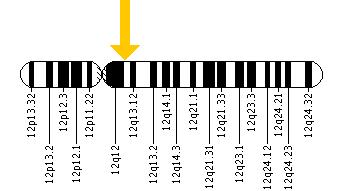 |
||
| http://ghr.nlm.nih.gov/ A service of the U.S. National Library of Medicine® | ||
The official name of this gene is “keratin 81.”
KRT81 is the gene's official symbol. The KRT81 gene is also known by other names, listed below.
The KRT81 gene provides instructions for making the type II hair keratin K81 protein (K81). This protein belongs to a group of proteins known as keratins, which are tough, fibrous proteins that form the structural framework of cells that make up the hair, skin, and nails. Each keratin protein partners with another keratin protein to form molecules called intermediate filaments. These filaments assemble into strong networks that provide strength and resiliency to the tissues and protect them from being damaged by everyday physical stresses. The K81 protein is found in cells that make up the inner compartment of the hair shaft known as the cortex, and this protein helps give hair its strength and elasticity.
The KRT81 gene belongs to a family of genes called KRT (keratins).
A gene family is a group of genes that share important characteristics. Classifying individual genes into families helps researchers describe how genes are related to each other. For more information, see What are gene families? (http://ghr.nlm.nih.gov/handbook/howgeneswork/genefamilies) in the Handbook.
At least two mutations in the KRT81 gene have been identified in people with monilethrix, a hair condition characterized by strands of hair with a beaded appearance and short, brittle hair that breaks easily. Mutations associated with this condition change a single protein building block (amino acid) in the K81 protein. The amino acid changes usually occur in a region of the K81 protein thought to be important in intermediate filament formation. In people with monilethrix, the cortex of the affected hair shaft appears abnormal. However, it is unclear how mutations in the KRT81 gene are related to the abnormality in the cortex or the beaded appearance of the hair.
Cytogenetic Location: 12q13
Molecular Location on chromosome 12: base pairs 52,679,696 to 52,685,298

The KRT81 gene is located on the long (q) arm of chromosome 12 at position 13.
More precisely, the KRT81 gene is located from base pair 52,679,696 to base pair 52,685,298 on chromosome 12.
See How do geneticists indicate the location of a gene? (http://ghr.nlm.nih.gov/handbook/howgeneswork/genelocation) in the Handbook.
You and your healthcare professional may find the following resources about KRT81 helpful.
You may also be interested in these resources, which are designed for genetics professionals and researchers.
See How are genetic conditions and genes named? (http://ghr.nlm.nih.gov/handbook/mutationsanddisorders/naming) in the Handbook.
acids ; amino acid ; cell ; epithelial ; gene ; Hb ; intermediate filaments ; keratin ; molecule ; mutation ; protein ; stress ; tissue
You may find definitions for these and many other terms in the Genetics Home Reference Glossary (http://ghr.nlm.nih.gov/glossary).
The resources on this site should not be used as a substitute for professional medical care or advice. Users seeking information about a personal genetic disease, syndrome, or condition should consult with a qualified healthcare professional. See How can I find a genetics professional in my area? (http://ghr.nlm.nih.gov/handbook/consult/findingprofessional) in the Handbook.